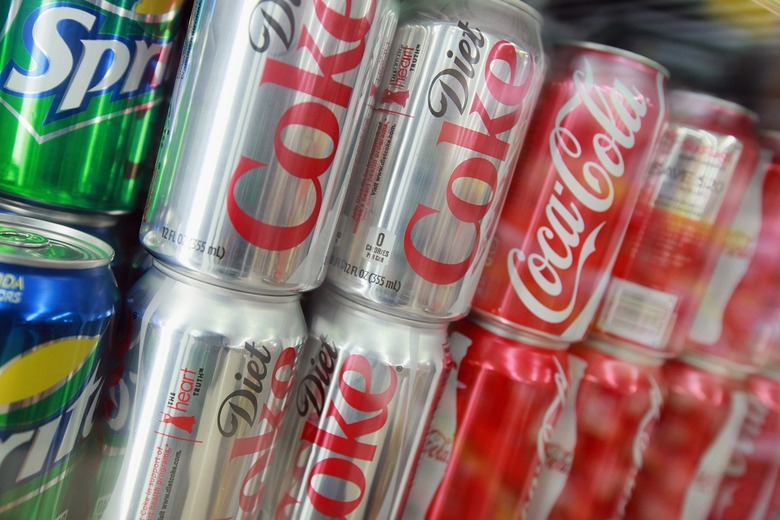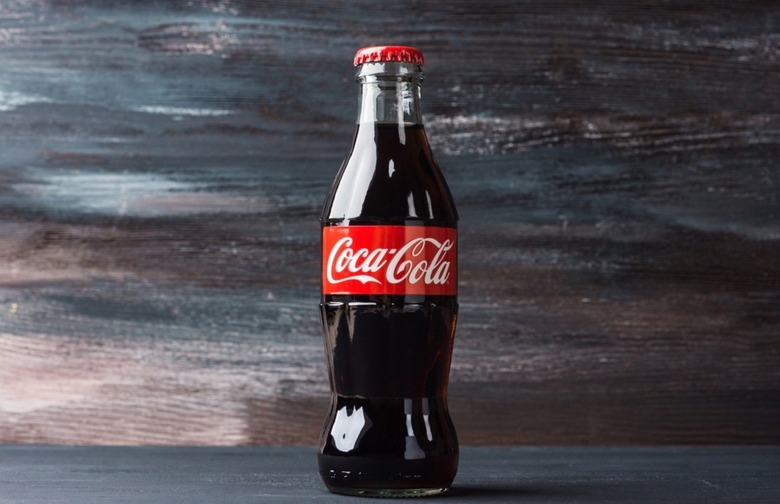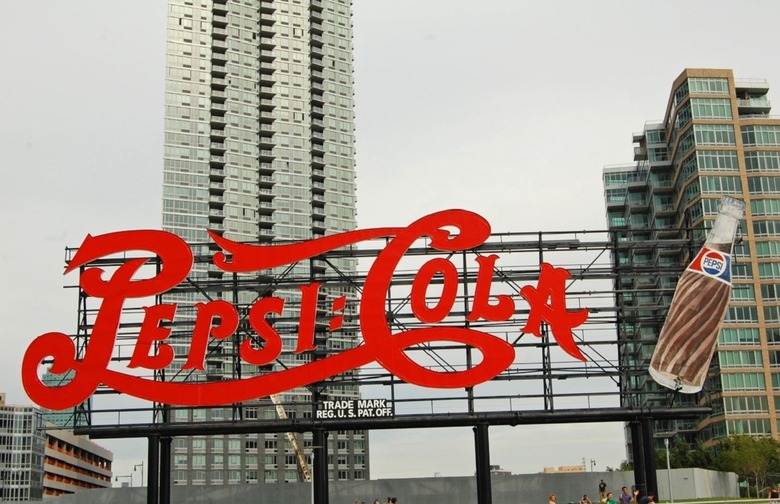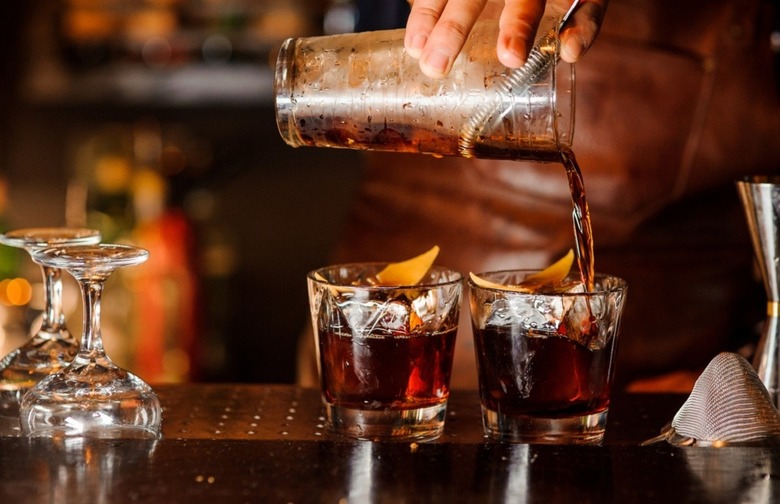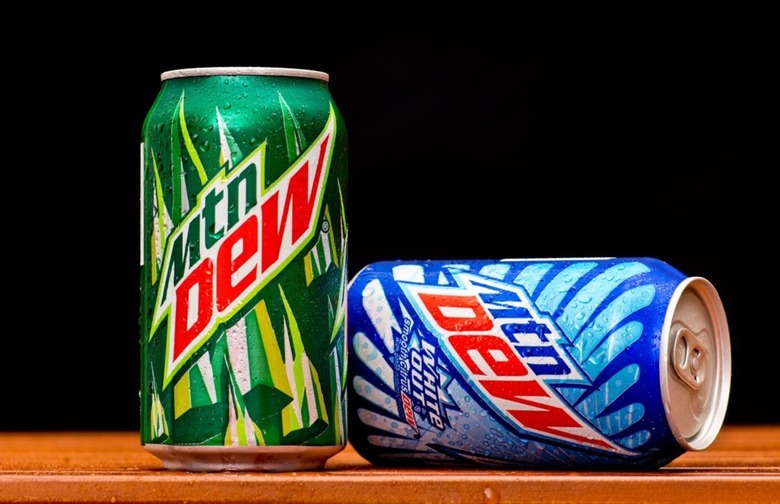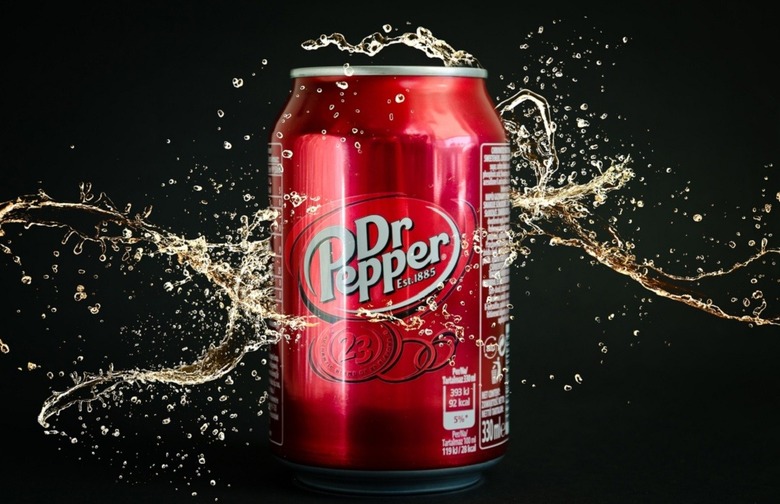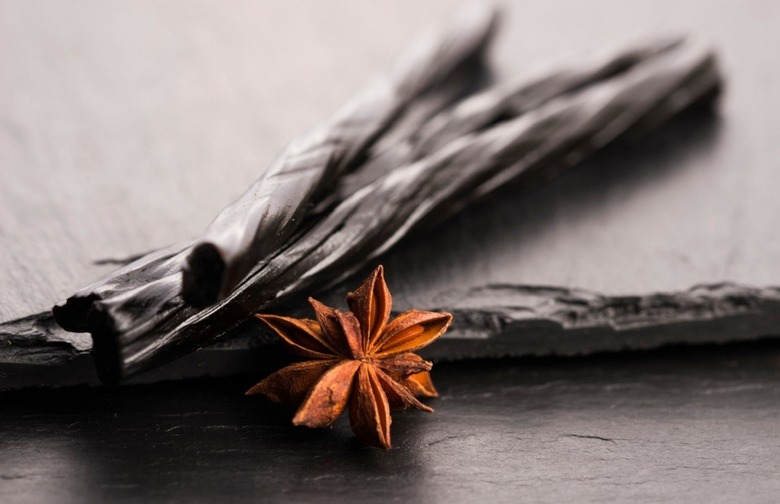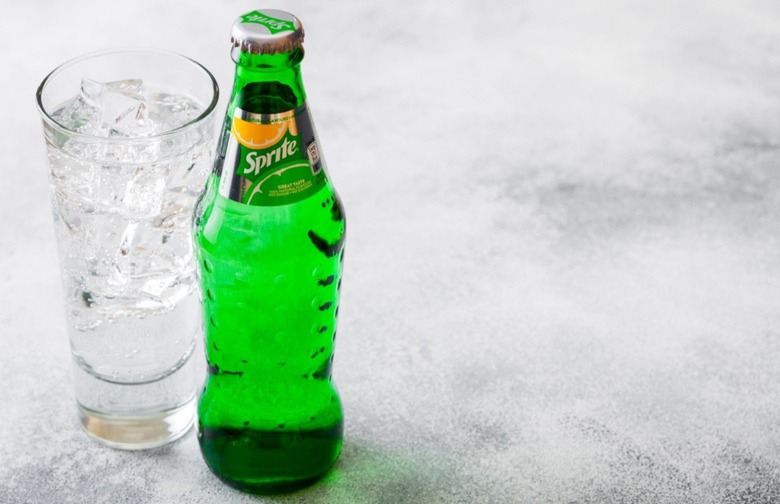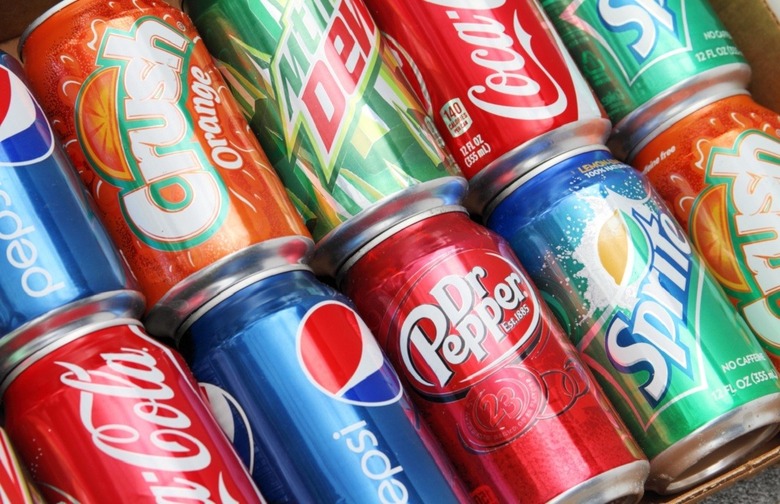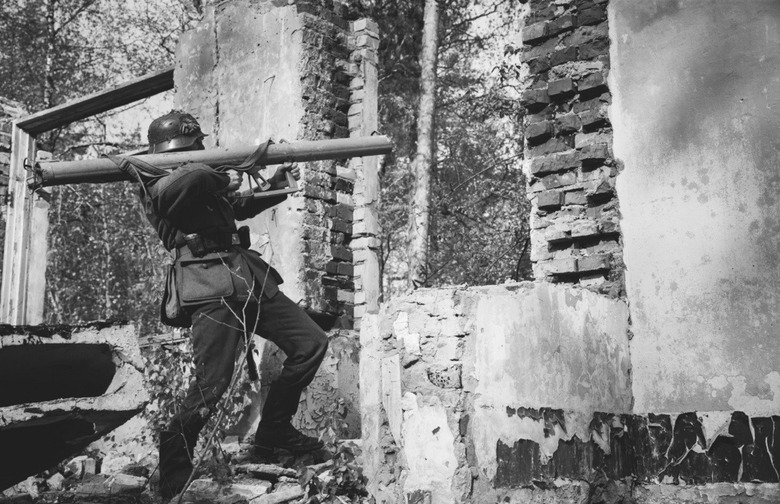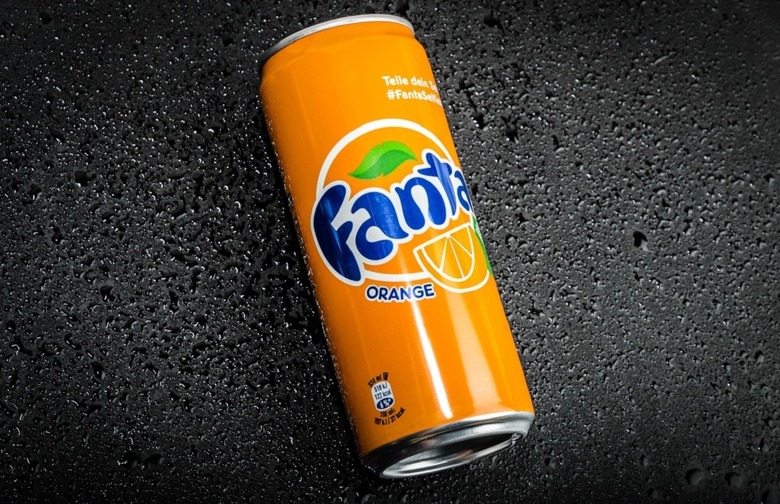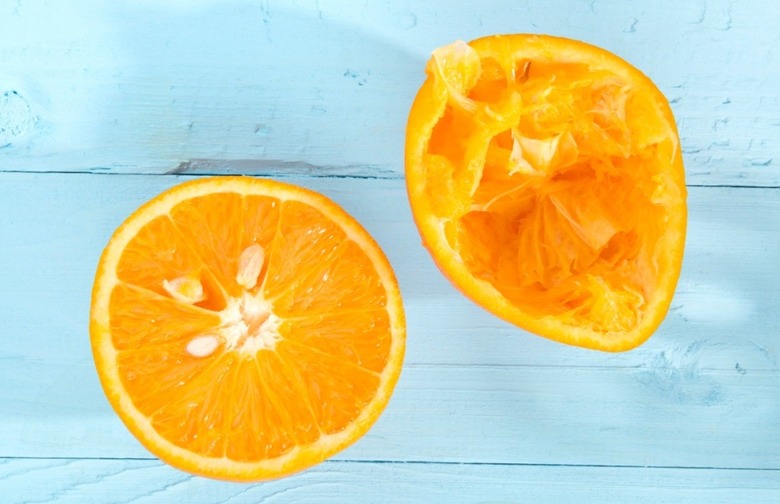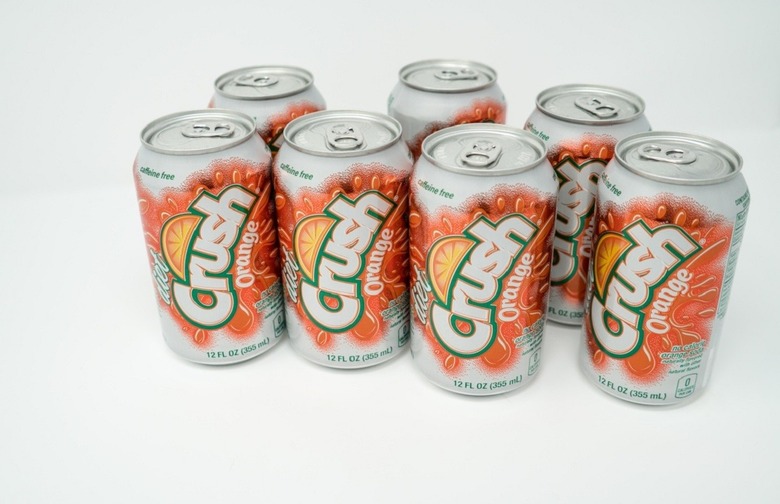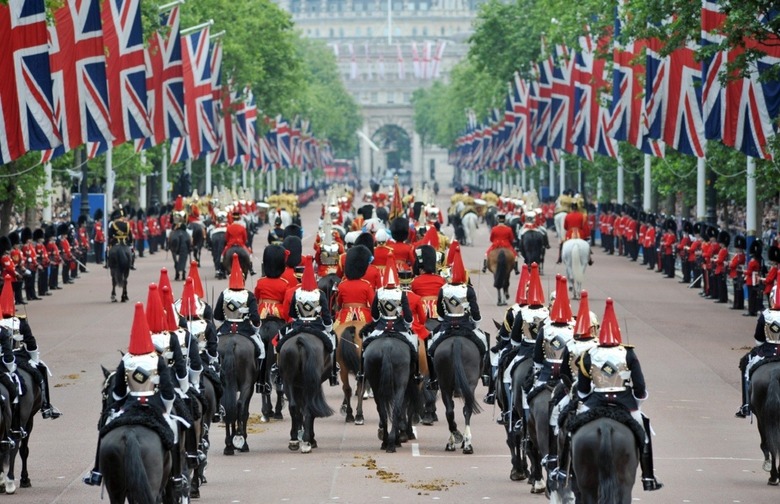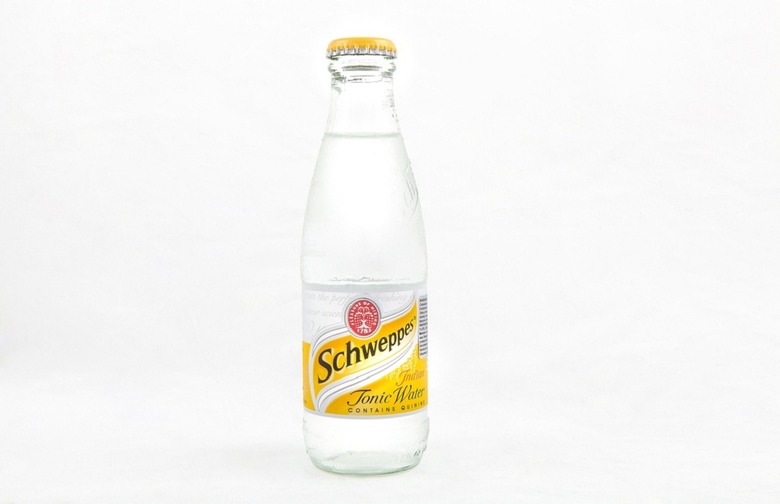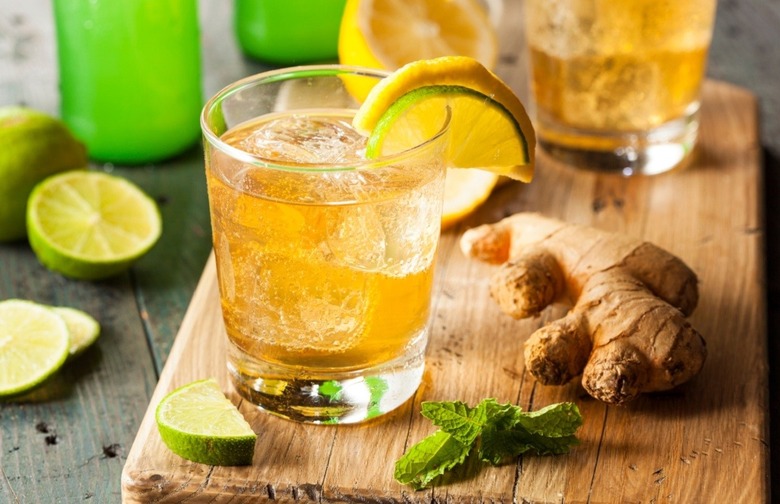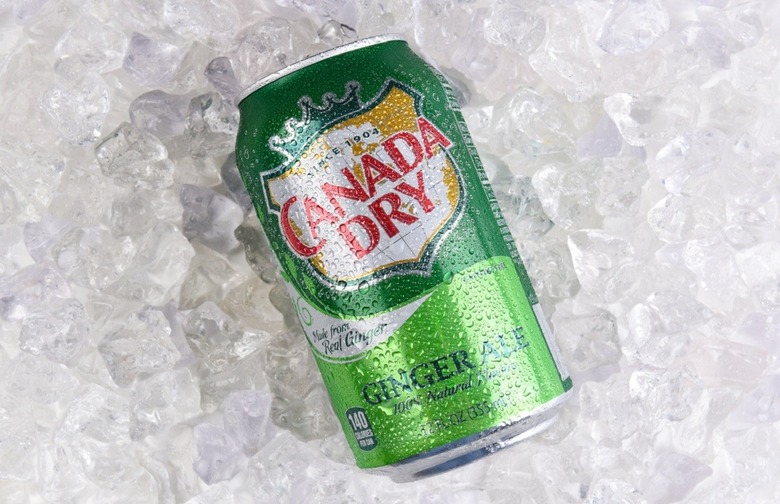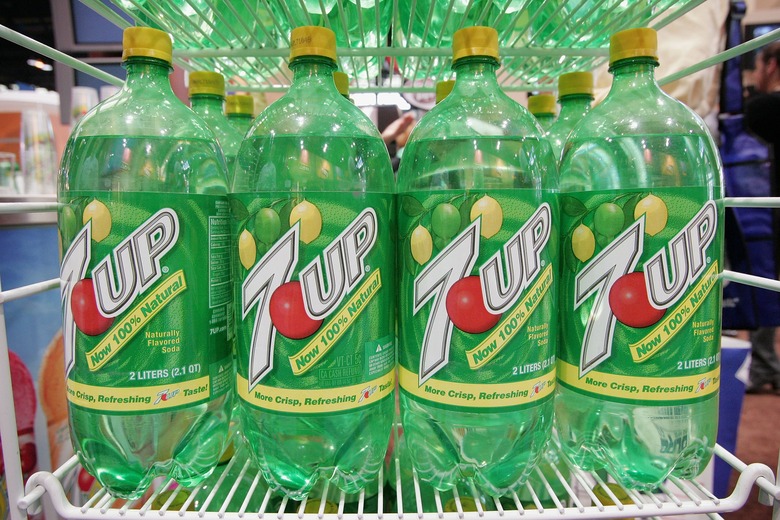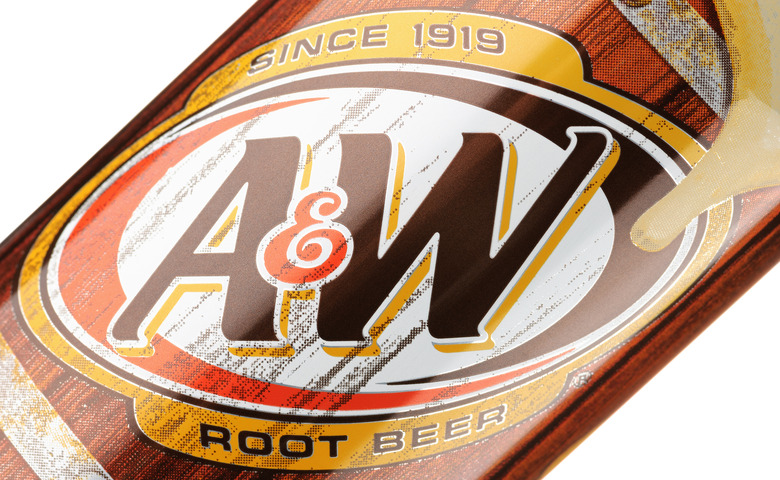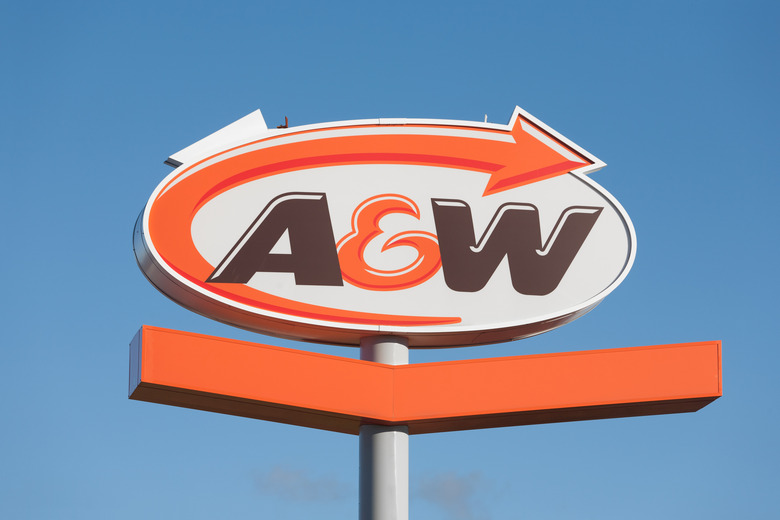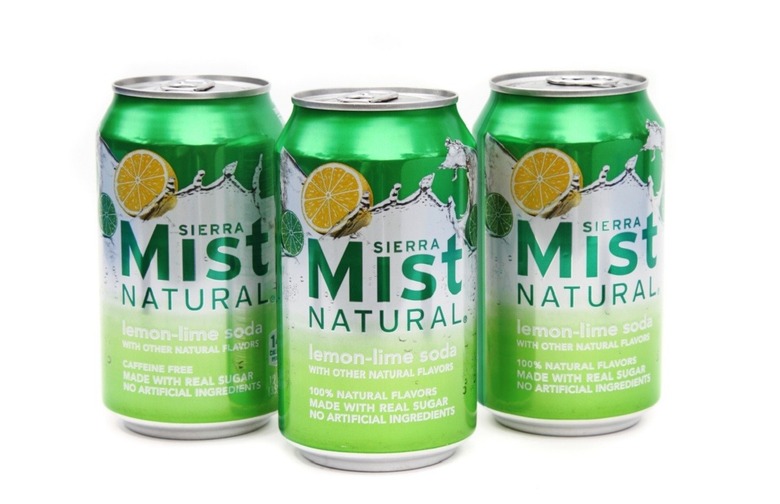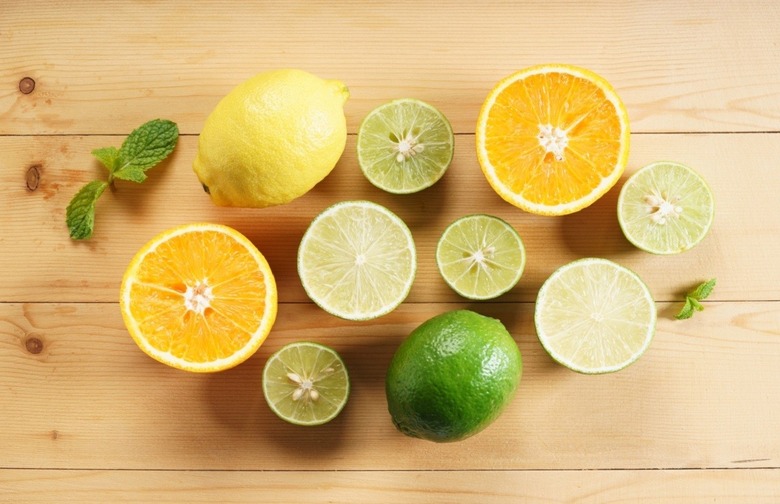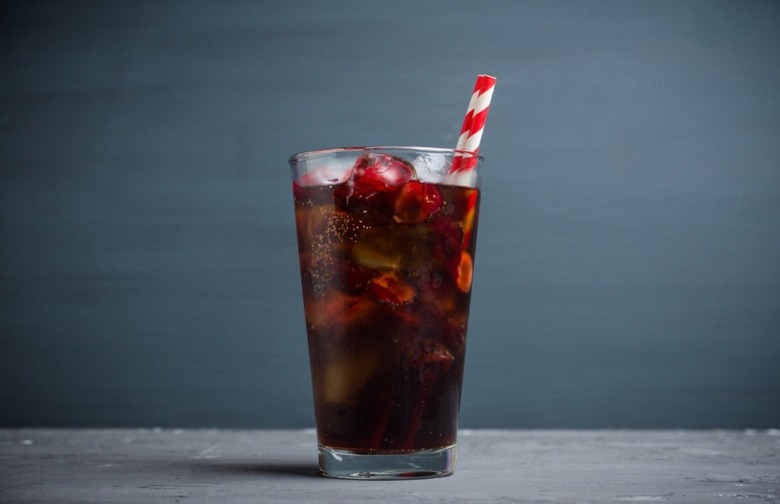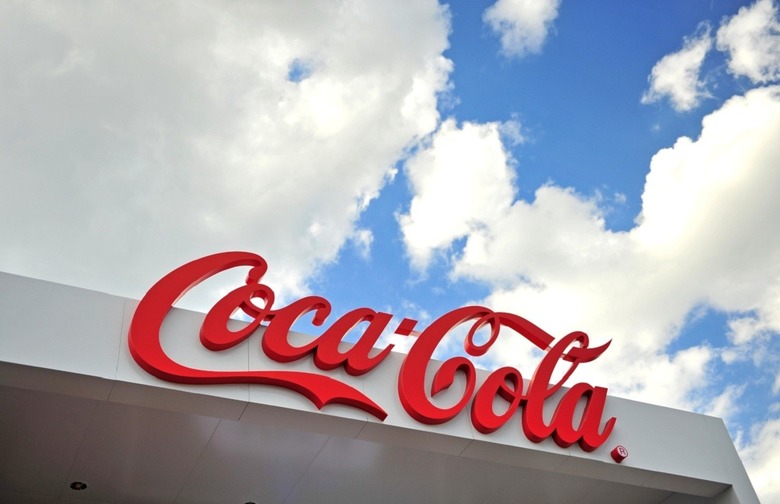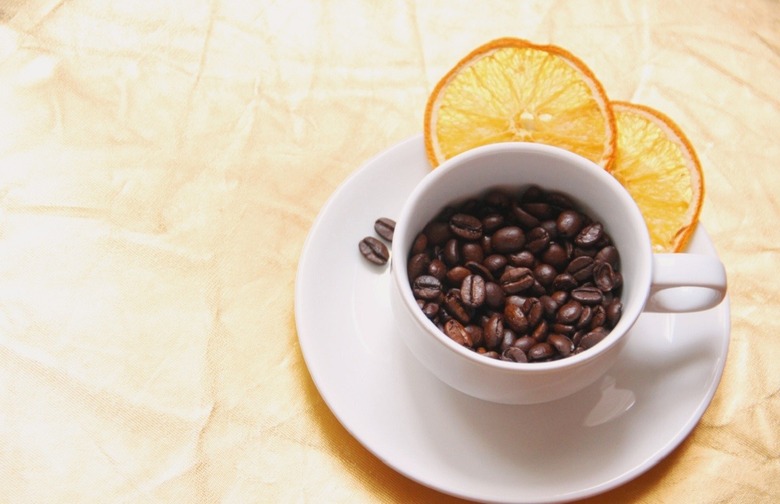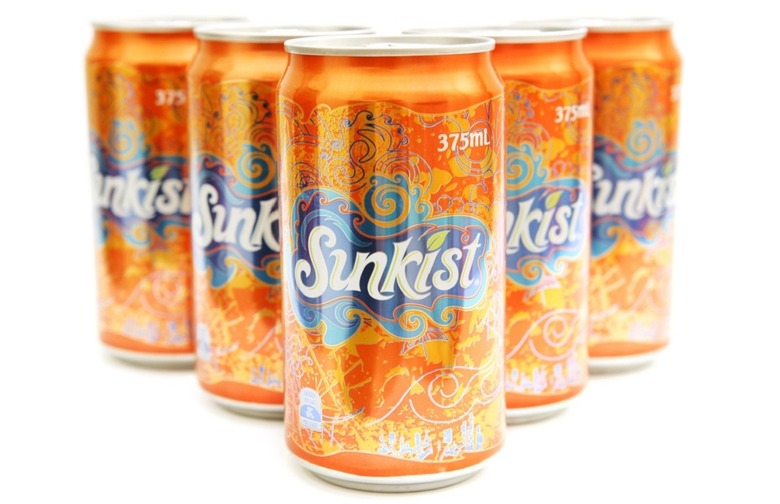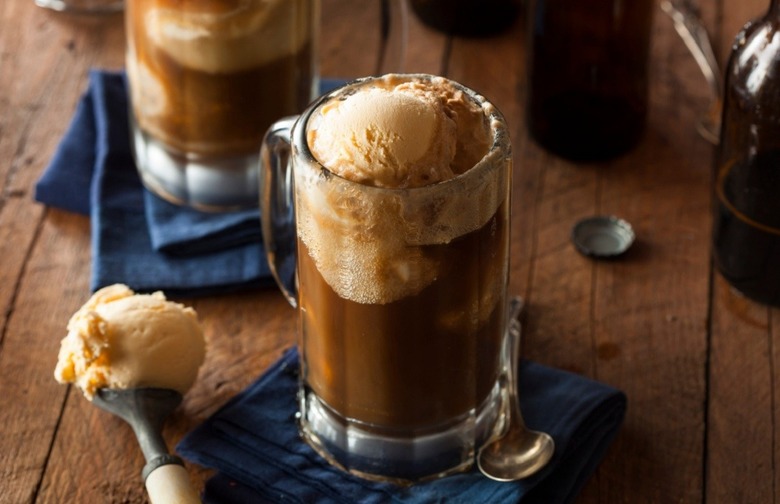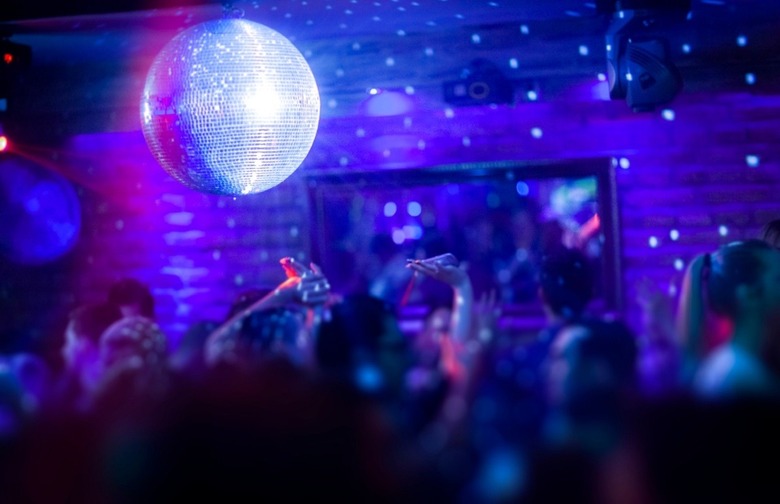Things You Didn't Know About 15 Of The Most Popular Soda Brands
Soda is the real MVP. We drink it with cake at birthday parties when we're young and order it mixed with whiskey at the bar when we're older. The nostalgic crack of a can or burst of fizz from an uncapped 2-liter could bring anyone back to the best days when all you needed was an ice-cold pop to combat the warm summer sun. Soft drinks like Coca-Cola, Mountain Dew and Dr Pepper are among the world's most recognized brands, and each of them also has a long history with quite a few unexpected twists and turns. Read on for things you didn't know about 15 of the most popular soda brands.
Coca-Cola was created as a substitute for morphine
After he was wounded in the Civil War, former Confederate Colonel John Pemberton became addicted to morphine, so he set out to find an opium-free alternative. The "brain tonic and intellectual" beverage he created at his Georgia-based drugstore, which included cocaine and alcohol, became the prototype for Coca-Cola's recipe.
Coca-Cola has been proven to help treat gastric phytobezoars
A phytobezoar is an indigestible mass that's trapped in the gastrointestinal system, the most common type being made of fiber from fruit and vegetables. According to science, Coca-Cola has been shown to effectively treat the condition. Over time, it will also break down other materials like teeth and flies (as will anything else with a similarly high level of acidity), but contrary to popular belief this won't happen overnight.
Once upon a time, Pepsi was ‘Brad’s Drink’
Pepsi was created in 1893 by Caleb Bradham, who anticlimactically named the soda "Brad's Drink." In 1898, it was renamed "Pepsi-Cola" after the root of "dyspepsia," meaning "indigestion," because it was believed that the soft drink could help break down food.
A Pepsi campaign slogan once really confused people in China
In the early 1960s, Pepsi came out with a catchy slogan: "Come alive! You're in the Pepsi generation." Long story short: That did not translate for speakers of Mandarin and Cantonese in China. They allegedly interpreted it as "Bring your ancestors back from the dead with Pepsi."
Mountain Dew was created as a mixer for whiskey
After spending some time in Georgia, Barney and Ally Hartman became accustomed to drinking whiskey with a lemon-lime soda called Natural Set-Up. There was nothing like it back home in Tennessee, so they developed Mountain Dew. The name is slang for moonshine. The soft drink was originally intended for their personal use only before it was discovered by bottler Charles Gordon, who helped bring it to a national audience. But the first recipe wasn't the same as today's; instead, it was a clear liquid that tasted more like Sprite.
Mountain Dew does not affect fertility
Legend has it that Mountain Dew kills sperm or affects fertility in some negative way. People think this because of the presence of caffeine and the dye yellow 5 (also known as tartrazine). Yes, they're both used in the soda, but medical experts say the quantities aren't high enough to actually lower a person's sperm count. Soda can affect your sex drive, though.
Dr Pepper is the oldest soft drink in America
Dr Pepper was invented by Brooklyn-born pharmacist Charles Alderton in Waco, Texas. It was first served in 1885 (a year before Coca-Cola) and introduced nationally in 1904 at the Louisiana Purchase Exposition in St. Louis, Missouri. That makes it the oldest major soft drink brand in the country.
Dr Pepper has more than 20 ingredients in its recipe
Specifically, there are 23 — and the exact ingredients are a company secret. Apparently, Alderton was trying to capture the smell of a soda fountain, and diehard fans speculate that the flavors are amaretto, almond, blackberry, black licorice, caramel, carrot, clove, cherry, cola, ginger, juniper, lemon, molasses, nutmeg, orange, prune, plum, pepper, root beer, rum, raspberry, tomato and vanilla. On top of that, no one even really knows where the name comes from, but it could be named after the father of a girl Alderton was once in love with.
Sprite was developed in Europe
This colorless soda was created in West Germany in 1959, but instead of Sprite, it was called Fanta Klare Zitrone (Clear Lemon Fanta). Two years later, it was introduced to the U.S. as Sprite to compete with 7UP. The flavor is often referred to as "lymon," a mashup of lemon and lime.
Sprite invented the art of shade
Alright, so there's no telling who truly invented the art of shade, but Sprite is pretty good at it. There's this hilarious horror-style "Sun Fizz" commercial and this extremely '90s ad called "Jooky," both of which poke fun at other soda brands. The tagline for the campaign was no less sassy: "Image is nothing. Thirst is everything. Obey your thirst." Sprite still uses the last chunk for marketing today.
Fanta was created in Nazi Germany
During World War II, it was nearly impossible to import Coca-Cola ingredients because of a trade embargo established against Germany. So Coca-Cola employees in Germany independently created Fanta to fill the void. Millions of bottles were sold during wartime, but many people didn't drink them. Because of strict sugar rationing, Fanta was used to flavor and sweeten soups and stews. The recipe we know today wasn't officially launched until 1955 in Naples, Italy, using locally sourced oranges instead of beet sugar, whey and apple pomace.
Fanta’s name is inspired by the word “fantasy”
The man credited with creating Fanta is Max Keith, who was the head of Coca-Cola Deutschland. When he was brainstorming a name for the drink, he told his employees to let their fantasie ("fantasy" in German) run wild. One of his salesmen immediately called out, "Fanta!"
Orange Crush used to include pulp in the bottles
Orange Crush was created in the early 1900s, but back then it was called "Ward's Orange Crush" after Neil C. Ward, partner to the company's founder Clayton J. Howell. The original recipe contained pulp so that customers would think it was made from freshly squeezed oranges — but the truth is that the pulp was added after the fact.
There have been some interesting Crush flavors
Though Orange Crush is still the most popular variation of this soft drink, there have been tons of different flavors over the years. Apparently birch (yes, as in the tree) is a local favorite in parts of Canada. At one point long ago, there was even a Chocolate Crush.
Schweppes was a Royal Family favorite
Before Schweppes made ginger ale, the company manufactured carbonated mineral water from a famous spring in England. This was used to treat indigestion and gout, but much of it was also sold to the British Royal Family, whose ties to the spring reportedly date back to Elizabeth I. One vintage advert reads, "These waters have always had the patronage of royalty and continue to be supplied to the queen." Coca-Cola (now Schweppes' parent company) shuttered their bottling plant near the famous well in 2010.
Schweppes was the first soft drink
Schweppes is considered by some to be the world's original soft drink due to the early success of the company's effervescent water. People called it "lightning in a bottle" because Schweppes' innovative bottle design made it the first of its kind to stay carbonated, and in the 1950s, the company coined the term "schweppervescence" to describe its crisp, fizzy bubbles.
Canada Dry was a popular mixer during Prohibition
Canada Dry Pale Dry Ginger Ale — also known as "The Champagne of Ginger Ales" — debuted in Canada in 1904 and started shipping to New York City around 1919. Its popularity as a mixer took off during Prohibition, when it was used to camouflage the unpleasant flavor of homemade liquor.
The name ‘Canada Dry’ used to actually describe the drink
7UP wasn’t always called 7UP
The original name for 7UP was "Bib-Label Lithiated Lemon-Lime Soda." Talk about a mouthful. Up until twenty years after its birth, the soft drink contained a trace of lithium citrate, which is now used to treat people with bipolar disorder and depression. The brand took advantage of this as a selling point until evidence of severe side effects emerged and the government banned its use.
7UP succeeded against all odds
When Charles Leiper Grigg invented 7UP in 1929, there were about 600 other lemon-lime sodas on the market. He spent months brainstorming ways to make his product stand above the rest. The winning formula was simply more fizz and less sugar.
A&W got its start at a roadside stand
In the summer of 1919, a guy named Roy W. Allen opened a root beer stand by the road in Lodi, California. Soon after, he expanded to Stockton and Sacramento. In 1920, Allen became partners with Frank Wright. The two combined their initials and called their soda A&W. Four years later, the brand opened one of the first franchised restaurant chains in America.
A&W has a mascot
A&W root beer has a mascot called the Great Root Bear, or Rooty for short. He first appeared in 1974, and by 1977 he had his own jingle on vinyl titled "Ba-Dum Ba-Dum," which was released as a single by Attic Records. Rooty's name isn't on the track, but Major Ursus is. It's a play on words for the constellation Ursa Major, which means "great bear." You can listen to the song here, but we must warn you the video is nightmare fuel.
The name Sierra Mist was originally intended for another drink
The name Sierra Mist was chosen from a list of more than 1,000 potential options by 2,000 participants. "Sierra" was a proposed name for Slice, the fruity soda invented in 1984. Sierra Mist replaced the lemon-lime Slice in 2000, and the rest of the line was pushed out by Tropicana Twister.
Sierra Mist rebranded for a few years
In 2016, Sierra Mist became Mist Twst to shift focus on the lemon-lime taste. Apparently that didn't pay off, though, because the soda reverted to Sierra Mist in 2018.
Pibb Xtra was sued over its original name
Long before it was Pibb Xtra, this cherry-flavored soft drink was called Peppo, which the Coca-Cola Company created to compete directly with Dr Pepper. The makers of its rival were not OK with the copycat brand name, so they sued and won. Peppo became Mr. PiBB. In 2001, a new cherry cinnamon flavor was introduced called Pibb Xtra. This replaced the original recipe in most U.S. markets.
Mr. PiBB was the subject of a very misguided marketing stun
In 1980, the Coca-Cola Company opened a contest for people to search their communities for the "PiBB Girl" for a chance to win $5,000. She wasn't actually a real person, but a composite of five of Hollywood's prettiest women. Contributions included "Mork & Mindy" actress Pam Dawber's hair, singer Debbie Boone's mouth, actress Susan Anton's eyes, actress Kristy McNichol's nose and "Little House on the Prairie" actress Melissa Sue Anderson's face shape. Ten finalists were flown to New Orleans, Louisiana, to stand before a panel of judges, but a winner was never publicly crowned due to backlash regarding the composite model's all-white features.
Sunkist sent people to the hospital in 2010
Unlike many other non-cola sodas, Sunkist is caffeinated — one 12-ounce can used to contain 41 milligrams, though that amount was recently lowered to 19. In 2010, consumers allegedly started getting sick (and even had to be hospitalized) after drinking 12-ounce bottles of the orange pop that had been mistakenly macro-dosed with caffeine. Each one was packed with 238 milligrams. That's more than two Red Bulls and just over two and a half cups of coffee.
Sunkist was the most popular orange soda in the country
Sunkist was first introduced in 1979 to compete with Fanta. Just one year later, it became the most popular orange soda and the 10th best-selling soft drink in America. It appears that Fanta has since regained the title.
Someone once made a pool-sized Barq’s float
In 1990, Barq's teamed up with Pick N Save grocery store in Dekalb, Illinois, to make the world's largest root beer float in an above-ground swimming pool in the parking lot. It took 1,500 gallons of Barq's root beer and 1,000 gallons of vanilla ice cream. Today, the float title is held by Coca-Cola. In 2007, the company filled a 15-foot-tall glass with 2,850 gallons of Vanilla Coke and 7,200 scoops of ice cream.
The birth of disco inspired Barq’s sugar-free option
In the '70s, disco became really popular and people flocked to the club to boogie down. According to the brand, "all that dancing created a bit of a health craze," so Barq's debuted its sugar-free root beer, "which was an instant success because, of course, it's good." Since then, experts have discovered that supposedly better-for-you soft drinks may not possess the health benefits consumers once thought they did, and these 19 facts about diet soda may make you finally stop drinking it.
More from The Daily Meal
Most Popular Soda From the Year You Were Born
America's 10 Best Burgers for Under $10
15 Reasons to Drink a Beer Every Day
25 Things You Didn't Know About Your Favorite Fast Food Chains
